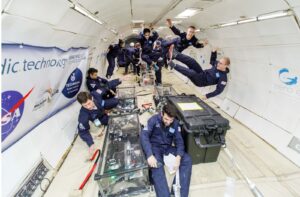“A scientific-technological breakthrough was recorded on the International Space Station, when astronaut Eytan Stibbe created optical components on the station using technology developed at the Technion. The experiment, a collaboration between the Technion and the NASA Ames Research Center, is part of the Ramon Foundation and Israel Ministry of Innovation, Science and Technology’s “Rakia Mission.” The innovative technology was developed at the Technion by the research team of Prof. Moran Bercovici from the Faculty of Mechanical Engineering. The experiment is based on fluid mechanics and aims to fabricate lenses using “fluidic shaping” in microgravity conditions. If the liquid used is a polymer, it can be hardened into optical components of any size.
In December 2021, in preparation for the experiment, Prof. Bercovici and his research team took off together for two parabolic flights. During these flights, a kind of micro-gravity was created for about 20 seconds through the “free fall” of the plane. The team tested their unique technology in these conditions and were able to successfully produce the liquid lenses in the allotted 20 seconds.
One of the expected applications of the innovative technology is the creation of large and precise lenses for space telescopes. These telescopes are of enormous importance both in the scientific mission of space exploration and in applied missions, including monitoring asteroids that endanger the Earth. The size of the telescope lens, which affects the obtained resolution, is currently limited by the constraints of launching the optical components. Launching production systems that include milling and polishing facilities is not realistic. Prof. Bercovici views his approach as a dramatic step on the way to creating large telescopes in space – a complex challenge faced by all parties engaged in space research.”

Watch below:
- Doumentation of the researchers leading the experiment watching its execution from the control room of the RAKIA mission, alongside photographs from Eytan Stibbe’s training on the experiment: in the documentation of the experiment appear: Dr. Eliran Rafael Hamo, the manager of the scientific payload and the control room of the RAKIA mission who accompanied the experiment and wears a NASA shirt, Prof. Moran Bercovici, the speaker, from the Faculty of Mechanical Engineering at the Technion, next to him is Omer Luria, a research engineer in the Technion Fluidic Technologies Laboratory and Mor Elgarisi, a doctoral student in the Technion Fluidic Technologies Laboratory.
2. Space transmitter – my experiment in space with Prof. Moran Bercovici:
